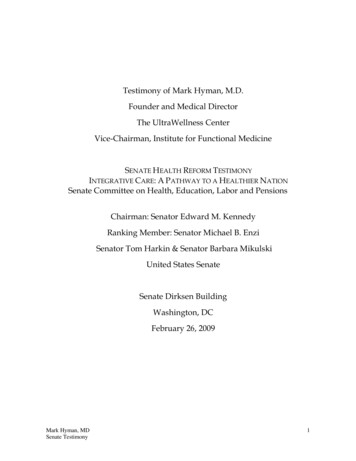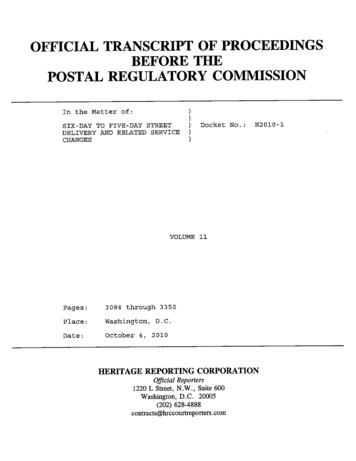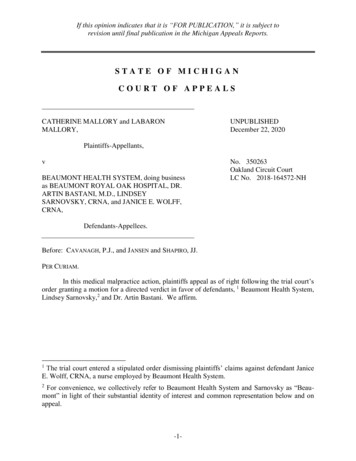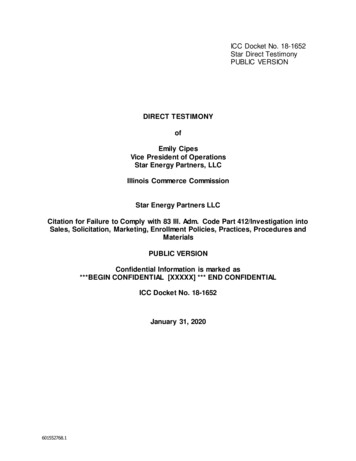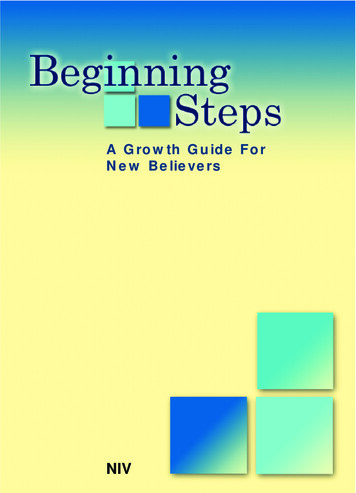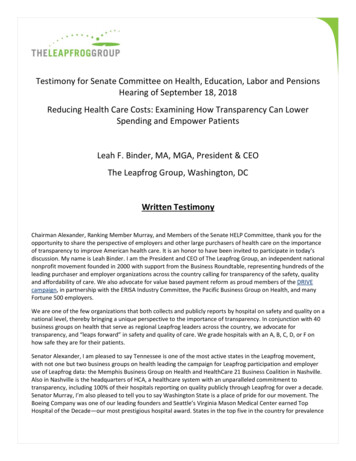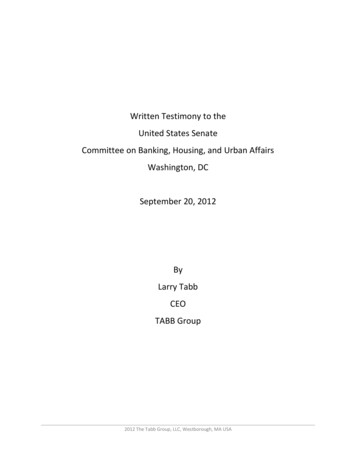
Transcription
Written Testimony to theUnited States SenateCommittee on Banking, Housing, and Urban AffairsWashington, DCSeptember 20, 2012ByLarry TabbCEOTABB Group2012 The Tabb Group, LLC, Westborough, MA USA
ContentsQuestion One: What are the benefits of automated trading of securities in our marketplace? Are thereany disadvantages? . 2Advantages. 2Disadvantages . 3Fragmentation and Time Priority . 5Averages Cover a Multitude of Issues. 7Exchange Rebates and Sub-Pennies . 8Dark and Internalized Order Flow . 9For-Profit Exchanges . 10Order Types. 11Dark Pool Order Types and Matching Priorities . 11Question Two: Does the current market structure allow all investors to participate in the marketmeaningfully and fairly? Why or why not? Are additional measures needed and appropriate to improvethe integrity of our market structure? . 12Fairness of the Current Market Structure. 12Regulatory Change Creates Trading Opportunities . 13Question Three: Have the high-profile computer trading failures over the past year, such as the recenttrading problem at one firm that sent stocks sharply higher and then lower over a period of minutes,discouraged ordinary investors from participating in the stock market? Have these failures and recentvolatility with initial public offerings discouraged companies from taking advantage of the capitalmarkets? . 14What Will Bring Back Confidence? . 16Question Four: What changes need to be made to help fortify our markets, especially during times ofmarket stress? In particular, is it possible to minimize the systemic effects of a flawed algorithm or acomputer strategy gone awry? . 17The best insulation from a rogue algorithm or trading model run amok are: . 17Question Five: Do regulators have adequate tools to identify and limit manipulative or abusivestrategies? . 19Question Six: What, if any, policy changes should be considered by regulators or Congress in order tobetter protect investors; maintain fair, orderly, and efficient markets; and facilitate capital formation? 20First, Do No Harm. 20What I Would Do. 20About TABB Group and Larry Tabb . 22TABB Group . 22Larry Tabb . 222012 The Tabb Group, LLC, Westborough, MA USA1
Question One:What are the benefits of automated trading of securities in our marketplace? Arethere any disadvantages?First, virtually all equity trading in the US is automated. From the 100-share order entered via the online broker tothe million-share order executed by the largest global asset managers, each and every order goes through a verysophisticated electronic execution process that encompasses: (1) a complex market data aggregation process; (2)the routing of the order from the investor to a broker: (3) the possible electronic internalization of that order atthe broker; and (4) a sophisticated smart-order-routing process to send unexecuted orders to Automated TradingSystems (ATSs) and/or exchanges for execution. In addition, there is a very sophisticated and electronic marketmaking process that allows investors, traders, and market makers to interact with incoming orders so they areexecuted efficiently and smoothly.AdvantagesThe benefit of this electronic execution framework isthe efficiency and the cost. Institutional investors payin the area of 1.08 cents per share for more self-Exhibit 1Institutional Equity Trading Commissions “Execution Only” 2011(Traditional Asset Managers – cents per share)directed orders and 2.05 cents for orders that needmore assistance (see Exhibit 1). Retail onlineinvestors are paying 8 to 10 a trade, regardless ofthe number of shares traded. The timeliness ofexecution is currently measured in milliseconds(thousandths of a second) and increasingly inmicroseconds (millionths of a second). Prior to theimplementation of Reg NMS in 2007, the executionspeed of the NYSE was greater than 5 seconds. Whilethe difference between milliseconds andSource: TABB Group “2011/12 US Equity Trading”microseconds may not seem significant, the difference between milliseconds and seconds can be huge. Manythings can happen in 5 seconds, and most of them are good for investors. Today, even online retail investors canobtain real-time market data, and can execute orders within a small fraction of a second. Unless the order is verylarge, it can receive sub-second execution at or better than the best bid/offer (NBBO) displayed in the market andall for under 10 a trade. This could not happen without significant automation.In addition, the electronic marketplace has made the marketplace overall more efficient, measured by volumetraded. High-speed computers are continuously analyzing millions of quotes a second and looking for incorrectlypriced assets, buying the theoretically cheaper ones, and selling the more expensive ones to bring prices in line.This is done on a millisecond basis between index futures and ETFs, equity options, and their underlying equities.2012 The Tabb Group, LLC, Westborough, MA USA2
This process, when markets are not in turmoil, efficiently absorbs both news and supply-and-demand informationand effectively prices assets according to market conditions. Automation is the lubricant that makes this processefficient and seamless.DisadvantagesComplexityOur fully automated markets are overly complex. There are 13 registered stock exchanges and 30 or more majorATSs, as well as four major wholesalers (brokers that buy orders from retail brokers) and a number of internalizingbrokers. Getting buyers and sellers to effectively meet (trade) becomes a very complex and sophisticated task,when there are dozens of venues that could house the buyer to your seller, or vice versa. Brokers needsophisticated smart-order-routing technologies to find the other side of the trade.This execution process typically includes: (1) determining if the broker wants to trade against the order (which islegal, as long as the execution price is at or betterthan the NBBO); (2) matching the order in theExhibit 2Equity Retail Order Flow Schematicbroker’s ATS (dark pool); (3) soliciting other clients totrade against the client order; (4) routing the order toother brokers’ ATSs; and (5) having other brokerssolicit possible contra orders. If all else fails and thebroker cannot find the other side of the trade, theythen send that order to an exchange. If the exchangecan’t match the order at the best price, the exchangeis mandated to route that order to the exchangedisplaying the best price (see Exhibit 2).Source: TABB Group “NYSE Retail liquidity Program”While this process is overly complex, the time scale ofthis activity typically happens sub-second. While complex this process is efficient, cheap, and fairly effective.The downside to this electronic messaging is threefold:1) Information leakage. Because orders are pinged around various brokers, ATSs, clients, and subsequentlyexchanges, at each place that a message stops, it disseminates a little information. If you are listening tothis information, you can discern trends very quickly. When you can spot a large buyer, it becomes easierto aggressively buy ahead of the investor, pushing the price away from that investor, and thensubsequently sell it to the investor at a higher price. The same process works for sellers as well. Now thisprocess does not generally impact retail investors, as their orders are generally not large enough to push2012 The Tabb Group, LLC, Westborough, MA USA3
the market; however, it is very impactful to larger investors (which actually invest the bulk of individuals’assets through mutual funds, pension funds, and professionally managed accounts).2) Market data distribution and management.Exhibit 3Consolidated US Exchange Market Data Transmission RatesThe amount of market data that is processedon any given day is voluminous. Currently, onan average day the US exchanges canproduce a peak level of 4 million to 5 millionmessages per second (over a minute). Thepeak messages-per-second level was hit on10/7/11 at approximately 6.6 millionmessages (see Exhibit 3). This data must bemanaged, analyzed, and stored. In addition, ifone of the exchanges has market dataSource: Marketdatapeaks.com, FIFproblems (the feed can go down, incorrecttime stamps, etc.), it can create catastrophicproblems, as people are no longer analyzing data and submitting orders; machines are spitting out ordersautomatically depending upon the market data. If the market data is wrong, unless the data is reallywrong, the trading engines assume it is right and trade accordingly. This was a contributing factor to theth1May 6 2012 Flash Crash .3) Market data arbitrage. Because the markets are fully electronic, small time increments, irrelevant tohumans, become trading opportunities. These opportunities are hard, if not impossible to eliminate. Ittakes light (data through fiber optics) approximately 1 millisecond to go 100 miles, or 1 microsecond to goabout 0.1 mile. Given that the NYSE and NASDAQ data centers are about 41 miles apart, it takes about 0.4microseconds for data to get from one venue to the other. For humans, this gap would be infinitesimal;however, for machines, it becomes an opportunity, and for some investors this gap can be a significantchallenge. Firms that are co-located (have their trading technology at or very close to the exchange) andobtain data directly from that exchange, will have at least a 0.4 microsecond advantage over a firm thatuses the aggregated market data feed provided by the Consolidated Tape Association/SecuritiesInformation Processor (CTA/SIP). The aggregated feed will always be slower than a direct feed, becausethe aggregated feed receives data from all the exchanges, aggregates and normalizes that data anddistributes it. The aggregated feed must wait to obtain data from all sites before it distributes it, while a1thFindings Regarding The Markets Events of May 6 2010, REPORT OF THE STAFFS OF THE CFTC AND SEC TO THE JOINTADVISORY COMMITTEE ON EMERGING REGULATORY ISSUES - eport.pdf2012 The Tabb Group, LLC, Westborough, MA USA4
direct feed just pumps data out of the exchange directly from the matching engine (where it is created).Even if direct feeds were banned, firms that were closer to the dissemination point (because of the speedof light issue) would be able read and act on this data faster than a firm with a data center a mile away, 6miles away, or 3,000 miles away in California.In addition, given the message pinging that occurs, once a trend is spotted, there is ample time for very quicktrading machines to react to this information.Fragmentation and Time PriorityThe fragmentation of the markets has been both good and bad. Historically, when the NYSE had the dominantshare of NYSE-listed market activity, the NYSE acted like a monopoly. Execution times were long, costs were high,and institutional investors were not happy with theirexecution quality. In 2004, TABB Group did our firstExhibit 4Largest Institutional Equity Trading Challenges 2004study of institutional investors, and 71% of theinstitutional investors’ traders we interviewedresponded that the NYSE specialist and marketstructure was their most significant challenge intrading the US markets (see Exhibit 4). Monopolies donot have any incentive to be efficient.The implementation of Reg NMS changed this. Itforced the NYSE to compete against other exchangesfor market share. This caused the NYSE to lower cost,Source: TABB Group “2004 Institutional Equity Trading”streamline their technologies, and expedite theiraverage execution time from approximately 11seconds, circa 2005, to under a millisecond today. ThisExhibit 5Market Fragmentation and Price Time Priorityis a good thing.The problem, however, is that once there are multipleplaces to trade, liquidity gets spread out amongexchanges, the time arbitrage play becomes moresignificant, trade size declines, and time prioritybecomes meaningless.Source: TABB Group2012 The Tabb Group, LLC, Westborough, MA USA5
If there is only one order book, the trade at the top of the book needs to be cleared (fully executed) before thenext trade can be started. This incentivizes larger orders, because the only way to go around the large order is topay more or sell for less. Once there are two places to trade, the large order can be easily bypassed (see Exhibit 5).This changes the incentive structures. Once there are two places to trade and an order no longer has primacy, thensize is no longer an incentive, speed is. If an order can be traded around, then orders will become smaller, so it isharder for others to guess my intention. Orders will also need to be more nimble; execution infrastructures willneed to analyze the different venues to determine where it is easier to be on the top of the book, and whichorders also have a higher probably of being executed.With the creation of multiple trading venues comes a need for market synchronization or arbitrage. This processensures that the price of an asset trading over multiple venues is consistent. In this day of computers and highspeed connectivity, a fragmented market means thathigh-speed, low-latency machines are needed to tradebetween the markets in order to keep prices aligned.Exhibit 6US Equities Trades, Shares, and Average Trade SizeThis market structure also forces trade size to declineand message speed and rates to increase. This isexactly what we have seen in the US markets. Theaverage trade size currently is approximately 300shares, down from about 1,500 shares per trade in1997 (see Exhibit 6). This trend also highlights theperverse issue that the large orders we see in themarket are most typically retail individual investorSource: TABB Group & Exchangesorders, instead of orders from large investmentmanagers who typically slice and dice their hundredthousand and million-share orders into 100-share and 200-share lots.The challenge is, what level of fragmentation is appropriate? Do we want a monopoly that has no incentive tolower price and increase efficiency? Or do we want a single venue to promote a more fair and egalitarian market?These are very challenging questions without a right or wrong answer.The real question becomes, if we do remain fragmented, how do we promote innovation, without creating anunfair playing field?2012 The Tabb Group, LLC, Westborough, MA USA6
Averages Cover a Multitude of IssuesMarket makers and many traders with short time horizons are typically profiting by capturing a spread. They try tobuy at the bid and sell at the offer. Traders using this strategy are more interested in the volume of shares tradedthan the actual price of the stock. A stock that trades 10 million shares is better than a stock that only trades 1,000shares, even if the spread of the less-liquid stock is 0.25 or even a full 1.00, while the spread of the more-liquidstock may only be 0.01. That is because 10 million x 0.01 ( 100,000) is a lot more than 1,000 x 0.25 ( 250) or1,000 x 1.00 ( 1,000). So market makers tend to be more active in higher volume (more-liquid) stocks.Historically, when the exchanges had more control of which firms had the best trading economics, the exchangesforced these firms (which were market makers) to cover both more- and less-liquid stocks. They tended to makemoney on the more-liquid stocks, break even on stocks with a moderate amount of liquidity, and they lost moneyon less-liquid stocks (no matter how wide the spread).As the economics of trading has changed, and exchanges have moved from industry utilities to for-profitexchanges, new non-market-maker electronic traders have been able to trade as efficiently, and in many casesmore efficiently than traditional market makers.This creates problems for less-liquid stocks. Because the economics are better for highly-liquid names, nonmarket-maker electronic trading firms quickly moved into the more-liquid names and ignored the less-liquidnames. This undercut the profitability of formal market makers by hurting their profitability in their most profitablenames (stocks). If market makers can’t make money in their most profitable names, then they surely can’t makemoney in their least-liquid stocks. This makes it difficult for traditional market makers to survive, making it harderto provide liquidity for less-liquid/small-cap names.This creates a market structure where the most liquidnames are traded very efficiently, with tight spreadsExhibit 7Number of US Corporations Traded on the NYSE, NASDAQ, andAMEX Exchangesand low costs. This is good. Because these are themost liquid names it also makes the overall marketstatistics look very good. However, the less-liquidnames become very hard to trade. The least bit ofactivity causes significant price volatility, and makes itharder for investors to either get into or out of thesestocks.Source: World Federation of Exchanges & TABB Group2012 The Tabb Group, LLC, Westborough, MA USA7
The more difficult to get into or get out of these stocks, the harder it is for larger institutions to take positions inthese stocks, and hence they shy away from buying them altogether.While this should create buying opportunities for undervalued stocks, unfortunately, for whatever reason, it hascaused a consolidation of the number of publicly traded companies. The number of publicly traded companies hasdeclined from approximately 10,000 in 1997 to under 5,000 today (see Exhibit 7). Now there are many otherreasons why companies are not going public besides market structure issues; however, there have been a numberof papers written on this impact and the recently passed JOBS Act tasked the SEC to investigate widening the2spread for less-liquid stocks to better understand this challenge .Exchange Rebates and Sub-PenniesPart of the market structure debate is the exchange rebate strategy. But to understand rebates, one needs tounderstand limit orders. Limit orders are like advertisements reinforced by regulatory edict. The customer lookingto execute in the market is obliged by regulation (Reg NMS) to go to the exchange displaying the best advertisedprice. Even if the customer goes into the wrong store looking to buy the product at a higher price, the store is notonly obliged to direct that customer to the store with the cheapest price, but they are mandated to actually takethem to the competing store with the best price (or at least a store matching the best price). This was the keyTrade-Through mandate implemented as part of Reg NMS.Having the best price is a critical aspect of exchangecompetition and can significantly swing exchangeExhibit 8Exchange Market Sharemarket share.Exchange competition is so fierce (see Exhibit 8), thatmany exchanges pay their merchandisers a small feeto advertise at their store. The equities market is soefficient (especially in highly liquid names) that thissmall fee can tip market makers’ and High FrequencyTraders’ (HFT) profitability. In addition, the fee/rebatestructure also creates incentives to brokers to routetheir orders to various exchanges.Source: TABB Group & Exchanges2“A wake-up call for America,” By David Weild and Edward Kim, November 2009, Grant c%20companies%20and%20capital%20markets/gt wakeup call .pdf“Market Structure Issues and Impact On Initial Public Offerings”, SEC Advisory Committee on Small and EmergingCompanies, June 8, 2012 - http://www.sec.gov/news/otherwebcasts/2012/weild 060812.pdf2012 The Tabb Group, LLC, Westborough, MA USA8
Many people fault the rebate structure and align it with the increase in high-frequency trading. Personally, I look atthe rebate structure as a way to populate exchanges’ order books and promote exchange competition. Ifexchanges didn’t offer rebates, the traders would just widen their spreads to capture the same amount of profit.Another way to look at exchange rebates is through the lens of sub-penny pricing.Under Reg NMS the SEC banned the listing of limit orders in sub-penny increments (e.g., 10.002). Dependingupon the aggressiveness of the market makers, quoting the fee/rebate dictates the net spread capture the marketmaker can achieve. So by having a 28-mil (28 cents per 100 shares) take fee and a 25-mil rebate means that theactual spread is no longer 1 cent and that the realized liquidity provisioning spread is 1 cent plus 0.25 x 2 or 1.5cents (1 penny spread plus two 25-mil rebates) and the realized take spread is 1.56 cents (1 penny spread plus two28-mil take fees) with the exchange pocketing the 0.06 cents.These rebates allow the market makers, liquidity providers or HFTs to quote more aggressively. So even if theyboth buy and sell at the same price, if they provide liquidity on both the buy and the sell, they can still make 5cents per 100 shares. Most institutional and individual investors, however, do not pay this fee. This fee generallygoes to the broker who routes that order.Does this rebate promote more trading? Yes it does. But it promotes the posting of limit orders, which is likeinventory and advertising to a store. A store without anything on its shelves or no way to advertise will have aharder time attracting customers. And it is the customers who benefit from the tight pricing and the full shelves.Dark and Internalized Order FlowApproximately 30% of US Equity order flow isexecuted off exchange. This is up from approximately18% in July 2008. This flow is either being internalizedExhibit 9Percentage of US Equity Order Flow That is Either Internalized orMatched in Dark Pools/ATSsby brokers or being matched in ATSs/dark pools (seeExhibit 9).A significant amount of retail order flow is internalizedby wholesalers, meaning that the broker responsiblefor executing these orders can buy (or sell) the retailorder as it comes from the investor, at or better thanthe prevailing price (see Exhibit 2). Over the past yearor two, the amount of flow that brokers internalizeSource: TABB Group, ATSs & Exchanges2012 The Tabb Group, LLC, Westborough, MA USA9
has hovered in between 15% and 20% of total US equity volume. In addition, approximately 13% of order flow ismatched in ATSs or dark pools. ATSs are automated matching systems that allow a broker’s customer’s order flowto interact, meaning two customer orders (buy and sell) can match directly within the ATS. While many ATSs caterto the matching of illiquid stocks, the largest ATSs have become so significant that as much at 50% of the volumeof some of the most liquid equities are traded in the dark.Many institutional investors prefer that their order flow be matched in the dark (which mostly happens outside ofexchanges – even though exchanges can match), because it disseminates less information. In addition, sincebrokers (and hence ATSs) see orders before they reach the exchange, brokers and hence investors who trade indark pools have access to order flow in advance of the exchange. This is all perfectly legal under SEC rules.ATSs and dark pools were initially created to help institutions match larger orders, however the average order sizein many ATSs is approximately the same size as orders in traditional exchanges. In addition, many of the largestATSs do not let their competitors into each other’s ATSs directly, they do let many non-competitive liquidityproviders in and they do let competitors in via third-party independent brokers so increasingly, ATSs andexchanges look very similar, except that exchanges have a much higher regulatory obligation than ATS andinternalizing brokers.While exchanges cannot quote in increments smaller than 1cent, ATSs have a much easier time matching at subpenny increments. In addition, ATSs do not need to publish their matching rules, order types, or even theirvolumes, in fact, ATS anonymity is protected by SEC under Reg ATS, so there isn’t a single consolidated list of ATSsand the SEC will only provide the information under a Freedom of Information Act filing.For-Profit ExchangesFor-profit exchanges are another aspect of our markets. In the era of member-owned exchanges, the membersowned the exchange. While exchanges could make rules that benefited the owners (and many times they did),they were not profit-oriented. They made rules that benefited the members, which had diversified businessmodels: some were specialists, some were brokers, some were agency traders, and some traded for their ownaccounts. They had a collective interest in a diversified book of business which represented their true businesses(retail and institutional brokerage as well as investment banking), not just their trading businesses. This pushed theexchanges to care about trading across the large, medium and small-capitalized stocks, as well as promoting thedevelopment of new companies within the markets and growing smaller companies into larger ones.Now exchanges are public for-profit entities. They don’t have members; they have shareholders, to whom theexchanges are responsible to maximize returns. In this era of fewer IPOs, it means that exchanges make moneyfrom trading, market data, and selling technology. Since the bulk of the trading is generated by the high-frequency2012 The Tabb Group, LLC, Westborough, MA USA10
traders in the most highly-liquid stocks, the exchange has the incentive to ignore less-active traders and less-liquidstocks.Now, I would virtually guarantee that no exchange will say that they are ignoring vast market segments; however,when they change pricing strategies, create new markets, or add new order types, they are not discussing theseissues as thoroughly with investors (who are not exchange customers) as they are with their largest “liquidityproviders” (who are more likely direct exchange customers) and provide the majority of their quotes.Order TypesAn order type is an electronic message that tells the exchange how to handle a specific order. The simplest ordersare limit orders and market orders. A market order tells the exchange to buy a product at the current price. A limitorder tells the exchange to only trade this order at a specific price and to display that price out to the market.While market orders and limit orders are the simplest order types, there are dozens of order types that range fromhidden (non-displayed), floating (move with the market), midpoint (trade between the best bid and offer), andothers. Some order types are very straightforward and easy to understand. Some are not.Some of these message types are very arcane, and while the exchanges are obliged to post these order types,many are not thoroughly described and may not behave like you would think they would. Depending upon theexchange and order type, there may be clear advantages and/or disadvantages to using them and unfortunately,learning the intricacies of some of the more arcane order types is not easy and anything but straightforward.Dark Pool Order Types and Matching PrioritiesWhile order types and price/time priority in exchanges may be complex, arcane and not thoroughly described, thematching methodologies in ATSs are not even posted. ATSs are not required to post or even describe to theirclients their matching or routing methodologies. TABB Group has been following many of the dark pools in the USmarkets for years many of whom report their volumes to us on a monthly basis, and never has a single ATS or darkpool
2012 The Tabb Group, LLC, Westborough, MA USA Written Testimony to the United States Senate Committee on Banking, Housing, and Urban Affairs Washington, DC September 20, 2012 By Larry Tabb CEO TABB Group . 2012 The Tabb Group, LLC, Westborough, MA USA 1 Contents



